The Busride Design Studio: Soupy Spaces
Domus India
|September 2016
With a brief that mentioned ‘make mistakes’, the interior design of a sprawling house in Pune is interpreted through a series of folding and compact objects – a multi-purpose cube and a seating terrain – that make the interior space an ambiguous and more conceptual arena. By transforming the overall experience from ‘living in rooms’ to ‘living amongst objects’, the design offers the opportunity for unpredictable relationships to be discovered with everyday object.

Soupy spaces have temporal dimensions. They are flexible, combinative, evolving, formative, generative, shared, excitable, transformative, experimental, associative, in-discriminate, competitive... They are not permanent, established or formed. They appear and disappear at will. But they are not undefined, ambiguous or compromised. They are spaces created for a particular duration (long or short) to harness available potentialities to meet a particular need. As the need diminishes so does the space. Soupy spaces allow for Re-alignment, Re-affiliation, and Re-association. But they are not direction-less or disorienting. Soupy spaces are inclusive spaces, co-owned, collaborative. In soupy spaces, formations like communities, professional groups, public are in constant flux. Soupy spaces are not non-hierarchical or permanently heterogeneous. Each formation achieves its particular hierarchies, its own level of heterogeneity, gendering, identities to meet a particular need. And as the need transitions into another, so does the space. Soupy spaces are not non-ideological spaces, but temporarily ideological spaces to address a particular need. Soupy spaces are de-territorialised spaces, boundaries are porous, frayed edges, walls are built as anchors and not as divisions.
Soupy spaces encourage thoroughfare, are accessible and connected. They are multi-centered and mobile. The soup comprises all kinds of disparate anchors, leftovers of old hierarchical social structures, huddles of like-minded people, fragments of historic spaces and coagulations of newer approaches, techniques, materials. Each of these anchors remains suspended within the soup, activated only by association or need.
Where are the most likely locations to create soupy spaces?

Diese Geschichte stammt aus der September 2016-Ausgabe von Domus India.
Abonnieren Sie Magzter GOLD, um auf Tausende kuratierter Premium-Geschichten und über 9.000 Zeitschriften und Zeitungen zuzugreifen.
Sie sind bereits Abonnent? Anmelden
Translate
Change font size

